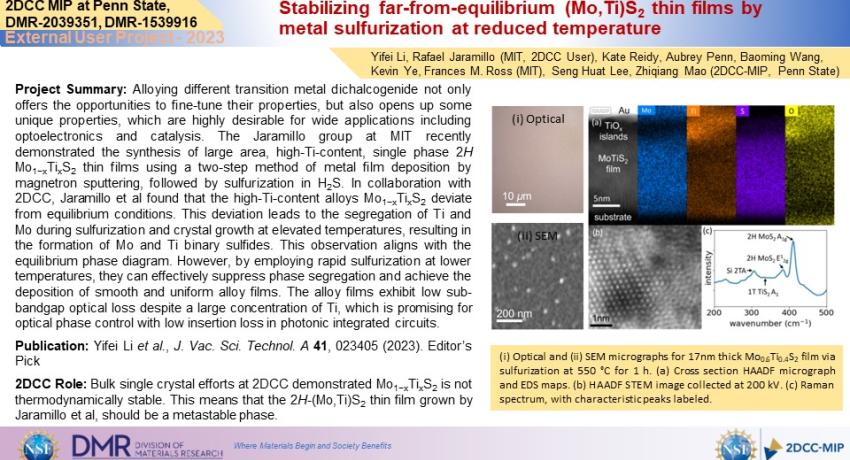Alloying different transition metal dichalcogenides not only offers the opportunities to fine-tune their properties, but also opens up some unique properties, which are highly desirable for wide applications including optoelectronics and catalysis. The Jaramillo group at MIT recently demonstrated the synthesis of large area, high-Ti-content, single phase 2H Mo1−xTixS2 thin films using a two-step method of metal film deposition by magnetron sputtering, followed by sulfurization in H2S. In collaboration with 2DCC, Jaramillo et al. found that the high-Ti-content alloys Mo1−xTixS2 deviate from equilibrium conditions. This deviation leads to the segregation of Ti and Mo during sulfurization and crystal growth at elevated temperatures, resulting in the formation of Mo and Ti binary sulfides. This observation aligns with the equilibrium phase diagram. However, by employing rapid sulfurization at lower temperatures, they can effectively suppress phase segregation and achieve the deposition of smooth and uniform alloy films. The alloy films exhibit low sub-bandgap optical loss despite a large concentration of Ti, which is promising for optical phase control with low insertion loss in photonic integrated circuits.
2DCC Role: Bulk single crystal efforts at 2DCC demonstrated Mo1−xTixS2 is not thermodynamically stable. This means that the 2H-(Mo,Ti)S2 thin film grown by Jaramillo et al. should be a metastable phase.
What Has Been Achieved: A synthesis demonstration of large area, high-Ti-content, single phase 2H Mo1-xTixS2 thin films via a two-step method of sputtering metal films and sulfurizing them using H2S gas and the demonstration of its metastable phase.
Importance of the Achievement: The two-step method is highly repeatable and compatible with wafer-scale deposition for alloyed TMD thin films that is useful for applications in chemical sensing and catalysis.
Unique Feature(s) of the MIP that Enabled this Achievement: The unique multiple temperature zone tube furnace enabled the 2DCC researchers to explore crystal growth of 2H-(Mo,Ti)S2 alloys in a large parameter space. This growth effort proved that 2H-(Mo,Ti)S2 is a metastable phase.
Publication (Editor’s Pick): Yifei Li, Kate Reidy, Aubrey Penn, Seng Huat Lee, Baoming Wang, Kevin Ye, Zhiqiang Mao, Frances M. Ross, and R. Jaramillo, “Stabilizing far-from-equilibrium (Mo,Ti)S2 thin films by metal sulfurization at reduced temperature,” J. Vac. Sci. Technol. A 41, 023405 (2023). Editor’s Pick. https://doi.org/10.1116/6.0002227.
Acknowledgments: This work was supported by an Office of Naval Research MURI through Grant No. N00014-17-1-2661. We acknowledge the use of facilities and instrumentation supported by NSF through the Massachusetts Institute of Technology Materials Research Science and Engineering Center under No. DMR-1419807. This work was performed in part at the Harvard University Center for Nanoscale Systems (CNS), a member of the National Nanotechnology Coordinated Infrastructure Network (NNCI), which is supported by the National Science Foundation under NSF Award No. 1541959. This work was performed in part in the MIT.nano Characterization Facilities. The bulk single crystal growth work was performed at the Pennsylvania State University Two-Dimensional Crystal Consortium–Materials Innovation Platform (2DCC-MIP), which is supported by NSF under Cooperative Agreement Nos. DMR-1539916 and DMR-2039351. K.R. acknowledges funding and support from an MIT MathWorks Engineering Fellowship and ExxonMobil Research and Engineering Company through the MIT Energy Initiative. We thank Colin Ophus for useful discussions on the utilization of PY4DSTEM package.
